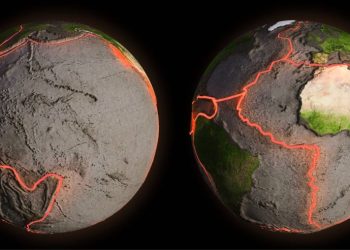A groundbreaking discovery of 50,000-year-old tree resin by an international team led by archaeologist Dr. Dylan Gaffney suggests that Homo sapiens may have migrated into the Pacific region far earlier than previously believed. This new evidence points to the use of advanced technological processes by early humans, indicating that their expansion into the Pacific islands may have begun as early as 55,000 years ago.
While some researchers have previously proposed an ancient human presence at the Madjedbebe rock shelter in northern Australia dating back thousands of years, these findings have been met with skepticism. However, the resin sample collected from Mololo Cave on Waigeo Island offers more compelling evidence. According to the research team, this discovery could push back the timeline for human colonization of the Pacific islands by thousands of years, highlighting the sophisticated methods employed by these early migrants.
In a study published in the journal Antiquity, Dr. Gaffney and his colleagues discuss the ongoing debate over the timeline of human expansion across the Pacific. While some evidence suggests that humans may have reached northern Australia as far back as 65,000 years ago, these dates have been contentious due to the lack of corroborating evidence along the likely migration routes. The accepted timeline for human arrival in the Pacific has been around 44,000 years ago. However, the discovery of manually collected and processed tree resin dating back 50,000 years on Waigeo Island challenges this notion, suggesting that humans may have migrated into the region 10,000 years earlier than previously thought.
The researchers note that the resin’s rectilinear shape, which is distinct from naturally formed resins, indicates that it was deliberately collected by humans. Further analysis using a scanning electron microscope revealed that the resin was produced through a multi-step process, as evidenced by various chipping and scraping marks. This suggests that early humans on Waigeo Island were engaged in complex plant processing techniques.
The findings from Mololo Cave are significant in the broader context of early human migration across the Pacific. The research team also conducted computer simulations of Pleistocene sea currents to explore how ancient seafarers might have navigated the waters between the islands. Their simulations suggest that successful crossings could have been achieved with minimal propulsion, even over short distances. This implies that early humans could have traveled between islands using simple paddling techniques, further supporting the idea of an earlier and more sophisticated migration process than previously understood.
While the exact purpose of the 50,000-year-old tree resin remains unclear, the research team speculates that it may have been used for various purposes, such as fuel for fires, boat construction, or attaching stone tools to wooden handles. The discovery of this ancient technology on a remote Pacific island provides crucial evidence for the early human occupation of the region, potentially predating previous estimates by thousands of years.
However, the researchers acknowledge that more work is needed to fully understand the implications of this discovery. They also raise the possibility that other ancient human populations, such as Denisovans or individuals with mixed Homo sapiens and Denisovan ancestry, may have played a role in this early migration. Further research will be essential to confirm these findings and to explore the full extent of early human expansion into the Pacific.
The discovery of 50,000-year-old tree resin on Waigeo Island offers compelling evidence of early human migration into the Pacific, potentially rewriting the history of human expansion in the region. This finding not only highlights the advanced technological capabilities of early humans but also opens new avenues for research into the origins and movements of ancient populations across the globe.











